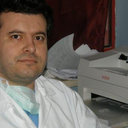Effect of dexmedetomidine on testicular torsion/detorsion damage in rats.
Paraules clau
Resum
OBJECTIVE
We assessed the antioxidant activity of dexmedetomidine (DEX) during an ischemic period in a rat model of testicular torsion/detorsion (T/DT) by using biochemical and histopathological methods.
METHODS
Wistar Albino male rats weighing 250-300 g were divided into three groups: sham (group S, n = 7); torsion/detorsion (group T/DT, n = 7), and DEX treatment (group DEX, n = 7). In the T/DT group, right testes were rotated 720 degrees for 1 h. Group S served for normal basal values. Rats in group T/DT were operated to make T/DT, this group served as a control group. Group DEX received intraperitoneal DEX 10 microg . kg(-1) after the 30-min torsion period. For measurement of total antioxidant enzyme activities and malondialdehyde (MDA) levels, testes of 7 animals in each group were excised after 4 h of reperfusion. Germ cell apoptosis was evaluated using the apoptosis protease-activating factor 1 (APAF-1) antibody in all groups and also on the expressions of endothelial nitric oxide synthase (eNOS) and inducible nitric oxide synthase (iNOS) were assessed within the bilateral testes.
RESULTS
Mean MDA levels in group T/DT were significantly higher than in groups S and DEX (p < 0.05). There were also significant decreases in mean total antioxidant activities in group T/DT when compared to groups S and DEX (p < 0.05). These values were significantly higher in group DEX than group T/DT. Germ cell apoptosis, eNOS and iNOS levels were significantly higher in group T/DT when compared to groups S and DEX (p < 0.05).
CONCLUSIONS
DEX treatment has potential biochemical and histopathological benefits by preventing ischemia/reperfusion-related cellular damage in an experimental testicular torsion model. Preference of DEX for anesthesia during the detorsion procedure may attenuate ischemia-reperfusion injury.


